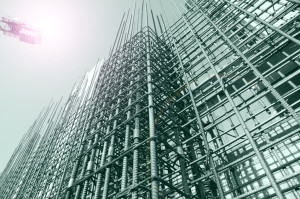New materials in structural engineering
 Although its output stands for decades or even centuries, few fields change as much or as profoundly as structural engineering. At the cutting edge of technological development, structural engineering embraces development and change.
Although its output stands for decades or even centuries, few fields change as much or as profoundly as structural engineering. At the cutting edge of technological development, structural engineering embraces development and change.
One side of structural engineering that’s surging today is the range of building materials. Not only are new materials emerging in the market, some traditional materials that have literally been used for millennia are making a comeback — albeit in a somewhat new form.
Carbon fiber
An outgrowth of the aerospace industry, carbon fiber has found use in a vast range of applications, from automobiles and bicycles to sports equipment and household items — and structural engineering.
Carbon fiber is lighter and far stronger than steel. Carbon fiber-reinforced rebar is used to retrofit some buildings to increase their resistance to earthquakes.
In Japan, a company has developed the CABKOMA Strand Rod. Made from inorganic and carbon composite fibers coated with thermoplastic resin, it’s the lightest seismic reinforcement technology available. CABKOMA rods are one-fifth the weight of metal wire of the same strength.
3d Graphene
Graphene is a form of carbon that normally occurs as a flat sheet, one atom thick. Theoretically, a graphene sheet can extend infinitely in length and width. It’s very light and very strong, but its basic shape has not, until recently, been very useful in structural engineering.
However, MIT researchers found a way to use 3D printing to shape graphene into a strong, stable, porous structure similar to coral or honeycomb. The result is a material that is one-twentieth the density of steel, but 10 times stronger.
The real advance in this is the geometric structure. The honeycomb or coral shape holds possibilities for energy storage, insulation, desalination and more uses.
While it’s still in the R&D phase, potential structural engineering applications include building frames that are lighter and stronger than steel or carbon fiber-reinforced steel, allowing taller buildings at lower costs.
Manufacturer AECOM is testing the weather durability of a graphene-impregnated polymer in an arch for supporting signals on railways in the U.K.
Advances in concrete
Durable, inexpensive and versatile, concrete has been used since the time of the Roman Republic, thousands of years ago. However, it is prone to wear, erosion and cracks, especially in climates like most of North America with frequent freeze-thaw cycles through the year.
The nature of concrete is that a crack tends to get worse over time, leading to crumbling and breaking.
Self-healing concrete mixes living spores and water capsules into the liquid concrete mix. These remain intact as the concrete hardens and sets. When something happens to crack the structure, the capsules break open, allowing the water to mix with the spores. This produces calcite, which bonds the concrete together again.
Self-healing concrete is now being used in buildings, bridges, tunnels and pavements. While it’s more expensive than standard concrete, its cost delta is mitigated by the longer life and reduced maintenance costs.
Illuminating cement has been around for years, by adding phosphorescent materials to the top layer of cement. The phosphorescent material absorbs sunlight during the day, even when it’s cloudy, emitting it after dark for up to 12 hours.
In 2016, researcher José Carlos Rubio at the Michoacan University of San Nicolás de Hidalgo, Mexico, announced a breakthrough: a phosphorescent concrete that will last at least 100 years. The producers can adjust the color and intensity of the light emitted.
The benefit is that it allows spaces to be lit without electricity. It’s now being tested in spaces that don’t need intense nighttime illumination, such as bicycle paths. It can be used indoors, as well, for security and decorative purposes.
Advanced bricks
Another ancient building material, clay bricks and ceramic tiles are seeing a renaissance. Air-cleaning bricks filter airborne particles as they enter structures. A professor at Cal Poly San Luis Obispo university invented a passive system where concrete bricks funnel air into an internal cyclone filtration system.
Cooling bricks and tiles combine clay and hydrogel. The hydrogel absorbs up to 500 times its weight in water. As it’s released during hot days, it helps to cool the interior, similar to the way we sweat.
Mass timber
Timber or wood is a traditional building material that has been displaced in much commercial construction by concrete and steel because of their superior strength and fire resistance. Now, mass timber is helping wood make a comeback. This is panelized, laminated solid wood for added strength and durability. Using it can reduce the cost of building, while also reducing the structure’s carbon footprint, because wood is a carbon sink.
Let’s talk structural engineering
Structural engineering is a dynamic field. By definition, we’re always searching for new, better and more cost-effective ways to solve building problems and achieve new heights.
At McNeil Engineering, we’d love to show you how we’re using the latest in building materials and techniques to help our clients achieve their goals. Give us a call at any time.

